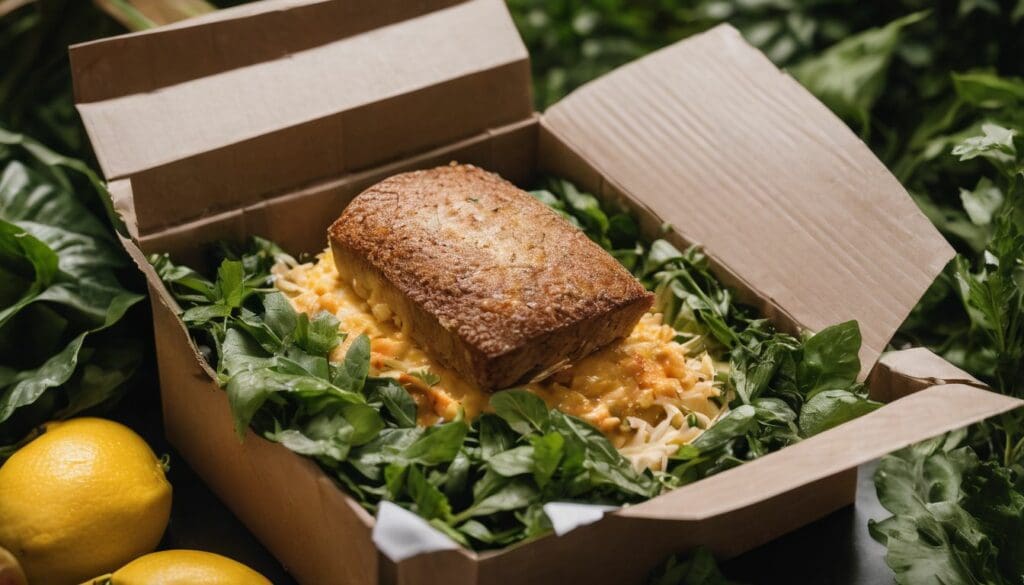We’ve all witnessed the dilemma; our bins teetering with plastics, a stark reminder of the environmental impact of traditional food packaging. The clarion call for change has never been louder, underscored by a poignant report from University College Cork that lays bare this pressing issue.
It’s with genuine excitement that we unveil in our forthcoming article some truly pioneering solutions poised to revolutionise the way we store and consume our sustenance. Imagine a scenario where your food’s wrapping isn’t merely a barrier against spoilage but is itself an appetising part of your meal—indeed, edible packaging is set to be the next tantalising chapter in responsible consumerism!
Key Takeaways
- Eco – friendly materials like corn starch, sugarcane, and bamboo are being used to create biodegradable packaging that decomposes naturally without harming the environment.
- Edible packaging is a growing trend in food storage options; it helps reduce waste by incorporating functional ingredients such as antioxidants and antimicrobial agents which extend product shelf life and offer health benefits.
- Advancements in nanotechnology facilitate the development of edible food packaging with enhanced barrier properties, improving sustainability while maintaining food safety and quality.
- Incorporating bioactive compounds into food packaging preserves freshness and extends shelf life, providing eco-conscious solutions for consumer products like fresh produce, meat, seafood, and ready-to-eat items.
- The future of sustainable food packaging includes grappling with regulatory compliance issues while understanding the environmental impact; nevertheless it presents immense potential for industry-wide transformation towards greener practices.
Overview of Current Food Packaging Options
Many traditional food packaging materials are not biodegradable, leading to environmental concerns. However, there have been advancements in the development of biodegradable and compostable packaging options that aim to address this issue.
These sustainable alternatives provide a promising solution for reducing waste and promoting eco-friendly practices in the food industry.
Traditional packaging materials
Plastic, glass, and metal have been the go-to choices for preserving our food for ages. Plastic wraps cling tightly to leftovers, glass jars house delicious pickles and preserves, and tin cans stack neatly in cupboards full of beans and soups.
We’ve relied on these materials because they’re durable and keep food fresh.
Yet, we can’t ignore their impact on the planet; traditional packaging often ends up in landfills or oceans. It’s time we recognise eco-friendly alternatives are not just nice but necessary.
Materials like corn starch, sugarcane, and bamboo offer sustainable pathways forward. They come from renewable resources that break down without harming the environment. Making a switch to biodegradable packaging options isn’t just about keeping up with trends – it’s about taking responsibility for the future of our planet while still enjoying our favourite snacks and meals.
Advancements in biodegradable and compostable packaging
With an increasing focus on sustainability, advancements in biodegradable and compostable packaging have become a key area of interest when it comes to food packaging. These materials offer environmentally friendly alternatives to traditional plastic packaging, addressing concerns about waste and pollution.
Market trends indicate a growing shift towards bio-based and biodegradable packaging materials as they align with the demand for eco-friendly options. The use of renewable resources such as corn starch, sugarcane, and bamboo has gained traction due to their ability to decompose naturally without leaving harmful residues or contributing to landfill waste.
Moreover, research is ongoing to continually improve these materials’ properties while also exploring new technologies that enhance their effectiveness in reducing environmental impact.
Edible Packaging: A Sustainable Solution
Edible packaging offers a sustainable solution to food packaging, reducing the environmental impact of traditional packaging materials. With characteristics and benefits like reduced waste and increased convenience, edible packaging is becoming a popular choice in the food industry.
Characteristics and benefits of edible packaging
Edible packaging materials, such as those made from seaweed or rice, offer a range of benefits. These sustainable alternatives not only provide an eco-friendly solution to food packaging but also help in reducing plastic waste.
Furthermore, edible packaging enhances the shelf life of products and helps in preserving the freshness of food items such as fruits and vegetables. In addition, these innovative materials contribute to reducing carbon emissions during production and disposal stages.
When it comes to characteristics, edible packaging stands out for its ability to biodegrade naturally without leaving harmful residues. The incorporation of organic compounds ensures that these materials are safe for consumption and do not pose any health risks.
Incorporation of functional ingredients
Functional ingredients such as antioxidants, antimicrobial agents, and vitamins can be incorporated into edible packaging materials to enhance food preservation and safety. These bioactive compounds not only extend the shelf life of products but also offer additional health benefits.
For example, the inclusion of natural extracts like green tea polyphenols or grape seed extract can help protect packaged food from oxidation and spoilage, thereby reducing food waste.
The combination of sustainable materials with these functional ingredients presents an innovative approach to eco-friendly packaging solutions that cater to both environmental concerns and consumer well-being.
Furthermore, the use of nanotechnology in edible packaging allows for the controlled release of functional ingredients, ensuring their effectiveness throughout the product’s lifespan.
Use of nanotechnology
Nanotechnology is revolutionising the development of edible food packaging by enabling the creation of nanocomposites with enhanced barrier properties and antimicrobial effects. Through the use of nanoparticles, such as zinc oxide and silver, these innovative materials can effectively prolong the shelf life of food products while maintaining their safety and quality.
Additionally, nanotechnology allows for precise control over the release of active substances, providing opportunities to incorporate natural antioxidants or antimicrobial agents into the packaging material itself.
This advancement opens up new possibilities for reducing food waste and enhancing sustainability in the food packaging industry.
As we explore the exciting potential of nanotechnology in edible packaging, it’s essential to consider its impact on addressing environmental concerns and improving food preservation techniques.
Nanocomposite materials offer an innovative pathway towards sustainable packaging solutions that align with our collective goal of reducing environmental impact while meeting consumer demands for safe and high-quality food products.
Novel Trends in Food Packaging
Incorporation of bioactive compounds and natural extracts in food packaging is revolutionising the industry, leading to innovative solutions for sustainable packaging. These novel trends not only reduce environmental impact but also enhance the shelf-life and quality of packaged food products.
Incorporation of bioactive compounds
Food packaging has evolved to incorporate bioactive compounds, which are natural substances that have a beneficial effect on human health. These compounds are integrated into the packaging material to extend the shelf life of food products and enhance their nutritional value.
Natural extracts such as antioxidants and antimicrobial agents are being used to create sustainable packaging options, contributing to eco-friendly alternatives for food preservation.
This innovative approach not only reduces food waste but also promotes environmental sustainability by harnessing the inherent properties of these bioactive compounds.
Utilising natural extracts in food packaging presents an exciting opportunity to address both consumer demand for healthier products and the need for sustainable packaging materials.
Utilising natural extracts
Natural extracts such as essential oils, antimicrobial compounds, and antioxidants are being incorporated into edible packaging to enhance its functional properties. These natural ingredients offer potential benefits in terms of extending the shelf life of food products and providing added value through their health-promoting properties.
By utilising natural extracts, edible packaging can contribute to reducing food waste and enhancing the sustainability of the overall packaging industry. The integration of these bioactive compounds into eco-friendly materials aligns with the growing demand for innovative packaging solutions that prioritise environmental responsibility and consumer health.
Utilising natural extracts in edible packaging not only aligns with the increasing need for sustainable alternatives but also presents an opportunity to harness the inherent benefits of plant-derived compounds.
Combination with other sustainable materials
Edible food packaging can be further enhanced by combining it with other sustainable materials like bio-based polymers and natural fibres. These combinations allow for improved structural integrity, moisture resistance, and barrier properties, making the packaging more versatile for a wider range of food products.
By integrating edible materials with biodegradable options such as corn starch or sugarcane, manufacturers can create innovative packaging solutions that not only reduce waste but also provide effective protection for various types of foods.
This approach aligns with the growing demand for environmentally friendly packaging in the food industry while promoting a circular economy that minimises environmental impact.
The incorporation of functional ingredients into edible packaging materials presents an opportunity to enhance their performance and extend shelf life while also offering additional health benefits to consumers.
For instance, adding natural extracts like antioxidants or antimicrobial agents to these materials can help inhibit microbial growth and preserve the freshness of perishable goods without relying on synthetic preservatives.
Applications of Edible Packaging
Edible packaging can be used for fresh produce preservation, meat and seafood packaging, and in ready-to-eat products. To learn more about how edible packaging is revolutionising the food industry, keep reading!
Fresh produce preservation
Fresh produce preservation is crucial for reducing food waste and ensuring that fruits and vegetables retain their freshness for longer periods. Edible packaging offers a sustainable solution, prolonging the shelf life of fresh produce while reducing the need for traditional plastic packaging.
Notably, eco-friendly materials such as corn starch and sugarcane can be used to create biodegradable containers that help in preserving the quality of fruits and vegetables during transportation and storage.
These innovative packaging options underscore the shift towards environmentally friendly solutions in food preservation.
Innovative developments in edible packaging also involve incorporating natural extracts with preservative properties, further enhancing the effectiveness of fresh produce preservation.
Meat and seafood packaging
Edible food packaging plays a crucial role in enhancing the sustainability of meat and seafood products. Packaging made from corn starch, sugarcane, and bamboo offers an eco-friendly alternative to traditional plastic packaging.
This not only reduces environmental impact but also ensures better shelf-life and safety for these perishable items. The incorporation of bioactive compounds in edible packaging materials further enhances the preservation of meat and seafood, contributing to reducing food waste while promoting sustainable practices.
Utilising natural extracts in edible packaging for meat and seafood is a promising trend that aligns with the growing demand for environmentally friendly options. The combination of these sustainable materials with other innovative technologies presents exciting opportunities to revolutionise food packaging, addressing concerns about the environmental impact of conventional packaging methods.
Use in ready-to-eat products
Transitioning from meat and seafood packaging, edible food packaging also finds its practical application in ready-to-eat products. From snack bars to pre-packaged salads, the use of edible packaging offers a sustainable solution for minimising waste and reducing the environmental impact of single-use plastic wrappers or containers.
Consumers can enjoy their favourite convenient foods while being assured that the packaging is biodegradable, safe for consumption or easily compostable after use.
Edible packaging materials used in ready-to-eat products include those derived from renewable resources such as corn starch, sugarcane, and bamboo. These materials not only enhance sustainability but also help in preventing soil and water pollution caused by traditional plastic wrappers.
Future Prospects
As new technologies continue to emerge, the future of food packaging looks promising. Regulations and challenges will need to be addressed as edible, biodegradable, and sustainable options become more widespread.
The potential impact on the food industry could be substantial, leading to a more environmentally friendly approach to packaging.
Technologies being developed
Researchers are actively developing technologies to enhance the sustainability of food packaging. Cutting-edge advancements include the use of nanotechnology to create edible films that can extend the shelf life of perishable products.
Additionally, innovations in bio-based polymers and smart packaging solutions are being explored to reduce food waste and environmental impact. These developments align with the growing demand for eco-friendly packaging options, reflecting a promising shift towards a more sustainable future in the food industry.
New sustainable materials such as algae-based bioplastics and cellulose nanocrystals are emerging as potential game-changers in edible and biodegradable packaging. Furthermore, ongoing research aims to address challenges associated with regulatory compliance and scalability, paving the way for widespread adoption of these innovative technologies.
Regulations and challenges
Regulations and challenges surrounding edible and biodegradable food packaging are crucial in ensuring the safety and compliance of these innovative materials. As demand for sustainable packaging options continues to rise, regulatory bodies are working towards establishing clear guidelines for the production, use, and disposal of edible packaging to maintain food safety standards.
Additionally, challenges related to scalability, cost-effectiveness, and consumer acceptance need to be addressed to facilitate wider adoption of eco-friendly packaging solutions within the food industry.
Overcoming these obstacles will play a significant role in driving the widespread implementation of biodegradable and edible packaging alternatives across various food product categories.
The introduction of new sustainable packaging options often presents complexities with existing waste management systems and infrastructure. Ensuring that these innovative materials can be effectively processed at end-of-life stages poses a major challenge for stakeholders involved in waste management and recycling processes.
Potential impact on the food industry
Given the increasing consumer demand for sustainable and eco-friendly food packaging, the potential impact on the food industry is significant. The shift towards edible, biodegradable, and sustainable options has led to improved environmental performance throughout the supply chain.
This change aligns with current trends in consumer behaviour, influencing purchasing decisions and driving innovation in packaging solutions that reduce waste and enhance sustainability measures.
Additionally, these advancements have created opportunities for businesses to reposition themselves as environmentally responsible entities. By adopting edible and biodegradable packaging materials, companies can appeal to a wider base of eco-conscious consumers while contributing to global efforts aimed at reducing plastic pollution and promoting a circular economy.
Conclusion
In conclusion, edible and biodegradable food packaging solutions offer a sustainable approach to addressing environmental concerns. These innovative options provide better storage, safety, and shelf life for food products while reducing plastic waste.
The expanding market value of these materials highlights their significant role in improving sustainability measures within the food industry. With ongoing technological advancements and increased public awareness, the future of food packaging is clearly shifting towards more eco-friendly alternatives.
FAQs
1. What does sustainable food packaging mean?
Sustainable food packaging involves using materials and methods that are eco-friendly and support food waste reduction, helping to protect the environment.
2. How is edible packaging changing the future of food?
Edible packaging offers a zero-waste option for consumers, as they can eat the package along with their food, cutting down on rubbish.
3. Can biodegradable materials really help reduce pollution?
Yes, by choosing biodegradable food packaging options over traditional plastics, we contribute less waste to landfills which helps decrease pollution levels.
4. Why are eco-friendly alternatives important in packaging sustainability?
Eco-friendly alternatives such as green packaging minimise the impact on our planet by reducing carbon footprint and supporting recycling efforts for a healthier ecosystem.
5. Is there more to eco-friendly packaging than just being good for the Earth?
Definitely! Eco-friendly packages also tend to be safer for health since they often contain fewer harmful chemicals compared with conventional plastic packagings.





